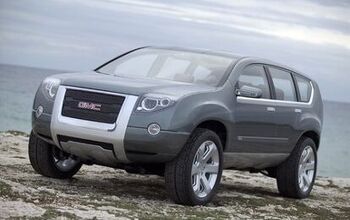General Motors Death Watch 86: Pickups Stick
Last Thursday, Mark LeNeve declared that General Motors has “turned a corner.” Obviously, GM’s Vice President of North American Sales and Marketing was unaware of the phrase’s historical baggage. To wit: General William Westmoreland’s famous announcement that the American war effort in Indochina had “turned a corner”– just before North Vietnam’s Tet Offensive returned the corner. Since ‘68, any US authority figure announcing an angle exceeded instantly reveals themselves as a master of unintended irony, and sets themselves up for an ignominious defeat.
Metaphorical misstep aside, LaNeve’s triumphalism seems to reflect normal corporate dishonestly. Surely LaNeve was simply lying when he claimed that “interest in new vehicle models such as the 2007 Chevrolet Tahoe SUV and a potential sales lift from upcoming products are helping put GM back in contention after excruciating declines in recent years.” After all, the statement is positively dizzy with spin. “Interest in new models” (as opposed to actual sales) is leading to a “potential sales lift” (as opposed to an actual sales increase) which is “helping to put GM in contention” (as opposed to putting GM back in the black) and reversing “declines in recent years” (as opposed to, say, declines during LaNeve’s tenure). But no, I honestly believe LaNeve honestly believes the unbelievable: that GM’s on the rebound.
You see, the thing is, the above statement about GM’s prospects isn’t a direct quote. It’s paraphrasing provided by automotive journalist Brett Clanton. In a Detroit News article on the GM Veep’s unbridled optimism, LaNeve’s surrogate spinmeister failed to provide any evidence for “growing signs that a massive turnaround effort at GM is gaining strength.” Sure, the article flags several ways GM could be derailed by “factors outside its control.” But its tone, tenor and existence all indicate that LaNeve’s comments reflect an accepted Detroit shibboleth: GM’s on the rebound!
By now, even casual observers know GM’s unofficial turnaround strategy: we’re gonna do what we’ve always done better than we’ve done it in “recent years.” Remember those intractable problems that brought us to the brink of bankruptcy: legacy and labor costs, bureaucracy, a bloated dealer network, badge engineering, ill-defined brands, etc.? Forgeddaboutit. We’ll just sell our best assets, close some factories, pay-off some workers, release a dozen or so new products (most of which look suspiciously like the old products) and everything will be allllllright.
My God, how wrong can you be? At last Wednesday’s press launch of GM’s new(ish) pickup trucks, GM Car Czar Bob Lutz once again explored the possibilities. “The effect [of high gas prices] will decrease over time as people adjust to the thought of $3 a gallon, just as they did when it was $2 a gallon and just as they did when it was $1 a gallon.” In other words, sooner or later, GM’s truck sales will return to “normal” and everything will be allllllright. And then GM CEO Rabid Rick Wagoner stepped up to the microphone and raised the stakes on Maximum Bob's bluff. GM’s new(ish) pickups are “the most important part of our North American turnaround plan.”
If that statement doesn’t send a shiver down Detroit’s collective spine, nothing will. Last month, GM’s pickup truck sales slumped thirty-two percent. While that’s a year-on-year comparison against last summer's Fire Sale For All program, it’s clear that GM’s second string cash cow is being gored by gas prices and, less obviously, a downturn in the housing industry. A SMALL company called BIGresearch says over 50% of pickup truck drivers planning on buying a new vehicle in the next six months are considering a more fuel efficient sedan or… wait for it… a hybrid.
Shrinking market? You betcha. Less profitable market? Uh-huh. Ford’s dropped the price on America’s best-selling pickup (the F150) by $1400. Toyota is about to enter the fray with its keenly priced, full-sized Tundra. Bottom line: the pickup truck market is contracting even as margins are being squeezed. At best, GM is about to make a great landing at the wrong airport. At worst, it’s missing the boat.
In today’s market, small cars are where it’s at. If GM thinks the Cobalt and Aveo can carry the corporation through another gas price escalation— even as Toyota, Nissan and Honda flood the market with their latest fuel-sipping econoboxes— they’ve got another thing coming. I reckon it starts with a “b.”
But even if you dismiss the possibility of Chapter 11, why do GM watchers grant the company turned around status when its leaders [continue to] refuse to provide a timeline or targets for a return to profitability? Mark LaNeve’s and his supporters may hide behind vague claims that they can see the light at the end of the tunnel, but they fail to understand that the beckoning light in the distance is… death.
More by Robert Farago
Latest Car Reviews
Read moreLatest Product Reviews
Read moreRecent Comments
- Master Baiter Mass adoption of EVs will require:[list=1][*]400 miles of legitimate range at 80 MPH at 100°F with the AC on, or at -10°F with the cabin heated to 72°F. [/*][*]Wide availability of 500+ kW fast chargers that are working and available even on busy holidays, along interstates where people drive on road trips. [/*][*]Wide availability of level 2 chargers at apartments and on-street in urban settings where people park on the street. [/*][*]Comparable purchase price to ICE vehicle. [/*][/list=1]
- Master Baiter Another bro-dozer soon to be terrorizing suburban streets near you...
- Wolfwagen NO. Im not looking to own an EV until:1. Charge times from 25% - 100% are equal to what it takes to fill up an ICE vehicle and 2. until the USA proves we have enough power supply so as not to risk the entire grid going down when millions of people come home from work and plug their vehicles in the middle of a heat wave with feel-like temps over 100.
- Kwik_Shift_Pro4X Where's the mpg?
- Grg These days, it is not only EVs that could be more affordable. All cars are becoming less affordable.When you look at the complexity of ICE cars vs EVs, you cannot help. but wonder if affordability will flip to EVs?


































Comments
Join the conversation
espo, the scion is the "fringe yuppie car" for toyota, not their main ride for small cars. Compare sales of chevy cobalt with say corolla their high volume small car. Then add the scion sales to the mainstream cars and you see that toyota is far out in front on small car sales. But the important thing is that toyota will make a profit on every small car gm will lose money on them.
http://biz.yahoo.com/ap/060816/the_new_subcompact.html?.v=7 In summary: Release of the New Silverado/Sierra reflects a lack of strategic foresight by GM. However the earlier-than-planned release is a solid tactical maneuver to capitalize as much as possible in a shrinking, but still large pickup truck market. Early release of the new Silverado/Sierra will further smother Ford's F-150 (which had been beaten in sales by the old Silverado/Sierra of late). Also, early release of Silverado/Sierra will sell thousands more units than if it had gone on sale later when it would have gone head-to-head with Toyota's new Tundra.